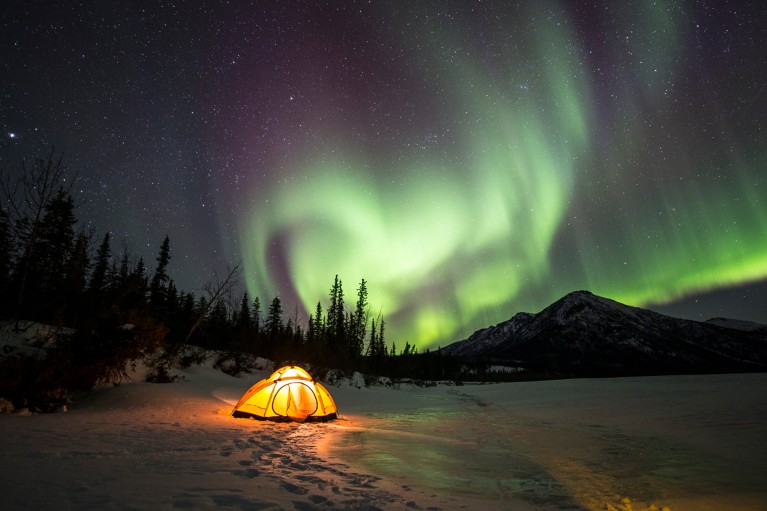Science
Related: About this forumGigantic oddball aurora seen from Earth for the first time
21 June 2024
A camera captured the vast, diffuse glow produced after the solar wind dropped to a whisper.
By Alexandra Witze

Green aurora borealis over an illuminated yellow tent by a frozen river at night.
Garden-variety auroras (pictured) take the form of pillars or curtains of light, whereas polar rain auroras are seen as diffuse glows across the sky. Credit: Chris Madeley/Science Photo Library
On Christmas night in 2022, a massive aurora lit up the sky for thousands of kilometres around the North Pole1. The light show gave scientists a unique glimpse of the elusive ‘polar rain aurora’, a rare shimmering phenomenon that forms when energetic electrons from the Sun cascade onto Earth’s polar regions.
Auroras form when charged particles flowing from the Sun hit and interact with Earth’s magnetic field. Their energy is usually transformed into light shows of dancing green curtains, towering red pillars, or other spectacles such as those that dazzled skywatchers around the world in May.
Polar rain auroras are a special type that form when electrons travelling directly from the Sun's corona, or outermost atmosphere, crash into Earth's atmosphere. Polar rain auroras are a special type that form when electrons travelling directly from the Sun's corona, or outermost atmosphere, crash into Earth's atmosphere. These auroras are rare because there are seldom enough of these electrons hitting the atmosphere to generate a glow. And other types of charged particles often interfere with these electrons, preventing polar rain auroras from forming.
When the wind died
But for 28 hours in December 2022, the flood of other solar particles — known as the solar wind — dropped to a trickle. The polar rain electrons showered unimpeded onto Earth, creating a greenish glow that spanned more than 3,000 kilometres across the North Pole.
More:
https://www.nature.com/articles/d41586-024-02072-7
BComplex
(9,139 posts)Thanks, Judi Lynn! ....As always! ![]()
BigmanPigman
(52,340 posts)I automatically thought this was a post about tRump, seriously. What a sad state of affairs for our country.
Arne
(3,607 posts)sl8
(16,252 posts)It's odd, the subheadline says, "A camera captured the vast, diffuse glow produced ....", but the only photo I see is the stock photo of a "garden variety" aurora.
I've searched online, but haven't found any definite polar rain aurora photos. The caption on the photo for the National Geographic piece sounds like it might be for the recent event, but looking at the metadata and reverse image lookup on the picture makes me doubt it. https://www.nationalgeographic.com/science/article/aurora-sun-polar-rain-solar-wind-rare
(On edit: the caption clearly indicates that the photo is of a "common" Aurora Borealis , as opposed to the polar rain variety.)
I have found artist depictions of earlier events.
Judi Lynn
(162,491 posts)First Ever Space Hurricane Spotted in Earth’s Upper Atmosphere
The 600-mile-wide swirling cloud of charged particles rained down electrons from several hundred miles above the North Pole
Alex Fox
Correspondent
March 5, 2021

An illustration based on the satellite observation data from the first confirmed instance of a space hurricane. Qing-He Zhang, Shandong University
Researchers have used satellite observations to identify what they’re calling a “space hurricane” in Earth’s upper atmosphere, Nature reports. The results, published last month in the journal Nature Communications, represent the first time a space hurricane has ever been detected over our planet.
The team spotted the churning mass of charged particles—ionized gas called plasma—hovering several hundred miles above the North Pole during a retrospective analysis of data collected in August 2014, reports Doyle Rice for USA Today.
“Until now, it was uncertain that space plasma hurricanes even existed, so to prove this with such a striking observation is incredible,” Mike Lockwood, an astrophysicist at the University of Reading and co-author of the paper, in a statement.
The space hurricane described in the paper measured roughly 600 miles across and rained down charged electrons instead of water for nearly eight hours as it spun counter-clockwise at speeds up to 4,700 miles-per-hour, per the paper.
More:
https://www.smithsonianmag.com/smart-news/first-ever-space-hurricane-spotted-earths-upper-atmosphere-180977176/
~ ~ ~
'Space hurricane' that rained electrons observed for the first time
The spiral-armed storm swirled roughly 125 miles over the North Pole, churning in place for almost eight hours.
March 4, 2021, 1:46 PM CST / Updated March 4, 2021, 3:42 PM CST
By Denise Chow
When it comes to extreme weather, it's safe to say a "space hurricane" qualifies.
Scientists said last week they observed a previously unknown phenomenon — a 620-mile-wide swirling mass of plasma that roiled for hours in Earth's upper atmosphere, raining electrons instead of water.
The researchers labeled the disturbance a space hurricane because it resembled and behaved like the rotating storm systems that routinely batter coastlines around the world. But until now, they were not known to exist.
"It really wasn't expected," said Larry Lyons, a professor of atmospheric and oceanic sciences at the University f California, Los Angeles. "It wasn't even theoretically known."
More:
https://www.nbcnews.com/science/space/space-hurricane-rained-electrons-observed-first-time-rcna328
sl8
(16,252 posts)Discoveries continue apace.